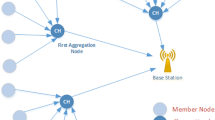Abstract
Efficient data aggregation helps in achieving maximum performance for complex interactive and sensing applications. In our proposed work, we have considered a heterogeneous sensor network which is partitioned into clusters. Each cluster is further divided into smaller information-based groups (also called similar groups) by the local processing center (LPC). The LPC acts as a cluster head and computes the probabilistic similarity of sensors by exploiting resemblance in the pattern of their sensed data. It further schedules the active and sleep duration of sensor nodes, such that only single node from every group remains active to participate in the aggregation cycle. The LPC gathers multi-characteristic dataset from the active clustered nodes and processes them by using probabilistic aggregation model. The proposed model normalizes the multi-characteristic data for deriving relative weights of each of the characteristic attribute. Finally, the aggregated information is transmitted to the global processing center. Our protocol is evaluated with wide range of performance metrics which includes aggregation gain, information accuracy, aggregation miss ratio, network lifetime and energy consumption.











Similar content being viewed by others
References
Akyildiz, I. F., & Weilian, S. (2002). Wireless sensor networks: A survey. Journal of Computer Networks, 38(4), 393–422.
Mhatre, V., Rosenberg, C. (2004). Homogeneous vs heterogeneous clustered sensor networks: a comparative study. The IEEE International Conference on Communications, 3646–3651.
Wang, Q., & Kenan, X. (2006). On lifetime-oriented device provisioning in heterogeneous wireless sensor networks: Approaches and challenges. IEEE Network, 20(3), 26–33.
Anastasi, G., Conti, M., Di Francesco, M., & Passarella, A. (2009). Energy conservation in wireless sensor networks: A survey. Ad Hoc Networks, 7, 537–568.
Khaleghi, B., Khamis, A., Karray, F. O., & Razavi, S. N. (2013). Multisensor data fusion: A review of the state-of-the-art. Information Fusion, 14, 28–44.
Pal, R., Gupta, B., Prasad, N. R., Prasad, R. (2009) Efficient data processing in ultra low power wireless networks: Ideas from compressed sensing. In 2nd International Symposium on Applied Sciences in Biomedical and Communication Technologies (pp 1–2).
Mhatre, V., & Rosenberg, C. (2004). Design guidelines for wireless sensor networks: Communication, clustering and aggregation. Ad Hoc Networks, 2, 45–63.
Chatterjea, S., Nieberg, T., Meratnia, N., Havinga, P. (2008). A distributed and self-organizing scheduling algorithm for energy-efficient data aggregation in wireless sensor networks. ACM Transactions on Sensor Networks, 4(4), article 20, 20:1–20:41.
Diaz, M. O., Leung, K. K. (2010). Randomized scheduling algorithm for data aggregation in wireless sensor networks. IEEE European Wireless Conference, 42–48.
Boulis, A., Ganeriwal, S., & Srivastava, M. B. (2003). Aggregation in sensor networks: An energy-accuracy trade-off. Ad Hoc Networks, 1, 317–331.
Yu, B., Li, J., Li, Y. (2009). Distributed data aggregation scheduling in wireless sensor networks. IEEE INFOCOM, 2159–2167.
Galluccio, L., Palazzo, S., & Campbell, A. T. (2009). Modeling and designing efficient data aggregation in wireless sensor networks under entropy and energy bounds. International Journal of Wireless Information Networks, 16, 175–183.
Li, H., Wua, C., Hua, Q. S., Lau, F. (2011). Latency-minimizing data aggregation in wireless sensor networks under physical interference model. Ad Hoc Networks, Article in press, 1–17.
Wang, P., He, Y., Huang, L. (2011). Near optimal scheduling of data aggregation in wireless sensor networks. Ad Hoc Networks, Article in press, 1–10.
Yu, B., & Li, J. Z. (2011). Minimum-time aggregation scheduling in duty-cycled wireless sensor networks. Journal of Computer Science and Technology, 26(6), 962–970.
Guo, W., Xiong, N., Vasilakos, A. V., Chen, G., & Cheng, H. (2011). Multi-source temporal data aggregation in wireless sensor networks. Wireless Personal Communications, 56, 359–370.
Ferrari, G., Martalò, M., Abrardo, A. (2012). Information fusion in wireless sensor networks with source correlation. Information Fusion, Article in press, 1–10.
Li, D., Zhu, Q., Du, H., Li, J. (2012). An improved distributed data aggregation scheduling in wireless sensor networks. Journal of Combinatorial Optimization, Springer, 1–20.
Nath, S., Gibbons, P. B., Seshan, S., Anderson, Z. (2008). Synopsis diffusion for robust aggregation in sensor networks. ACM Transaction on Sensor Network, 4(2), article. 7, 7-1–40.
Kalpakis, K. (2010). Everywhere sparse approximately optimal minimum energy data gathering and aggregation in sensor networks. ACM Transaction on Sensor Network, 7(1), article. 9, 9–2-9-26.
Zheng, J., Xu, X., Wang, G. (2011). Energy efficient data aggregation scheduling in wireless sensor networks. International Joint Conference of IEEE TrustCom-11/IEEE ICESS-11/FCST-11, 1662–1667.
Sinha, A., Lobiyal, D. K. (2011). An entropic approach to data aggregation with divergence measure based clustering in sensor network. International Conference on Advances in Computing and Communications (ACC), Part III, CCIS 192, 132–142.
Bagaa, M., Derhab, A., Lasla, N., Ouadjaout, A., Badache, N. (2012). Semi-structured and unstructured data aggregation scheduling in wireless sensor networks. 31st Annual IEEE International Conference on Computer Communications, 2671–2675.
Heinzelman, W. R., Chandrakasan, A. P., Balakrishnan, H. (2000). Energy-efficient communication protocol for wireless microsensor networks. In Proceedings of the 33rd Annual Hawaii International Conference on System Sciences, (pp 1–10).
Fall, K., Varadhan, K. (2009). The NS manual. The VINT Project.
Altman, E., Jemenez, T. (2003). NS simulator for beginners.
Issariyakul, T., Hossain, E. (2009). Introduction to network simulator NS2.
Author information
Authors and Affiliations
Corresponding author
Appendix A: Dissimilarity Coefficient
Appendix A: Dissimilarity Coefficient
The dissimilarity coefficient is a function to measure differences between two entities. Our proposed clustering and aggregation method uses the coefficient to detect the amount of dissimilarity existing in the sensed dataset gathered by pair of sensor nodes.
The dissimilarity coefficient is computed on every row entities that refer to the datasets sensed by cluster members. On simplifying the above equation, we get:
Moreover, the coefficient of dissimilarity satisfies following important properties:
Rights and permissions
About this article
Cite this article
Sinha, A., Lobiyal, D.K. Probabilistic Data Aggregation in Information-based Clustered Sensor Network. Wireless Pers Commun 77, 1287–1310 (2014). https://doi.org/10.1007/s11277-013-1566-1
Published:
Issue Date:
DOI: https://doi.org/10.1007/s11277-013-1566-1




